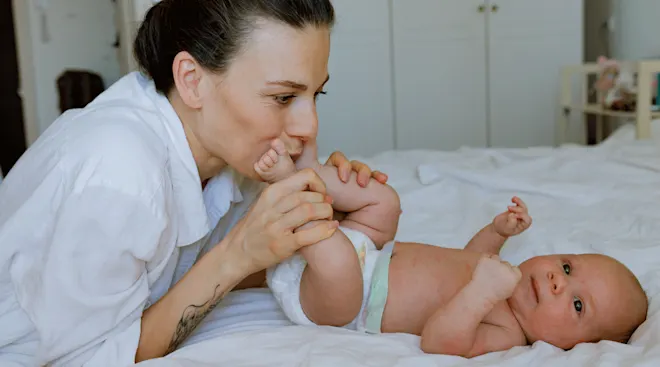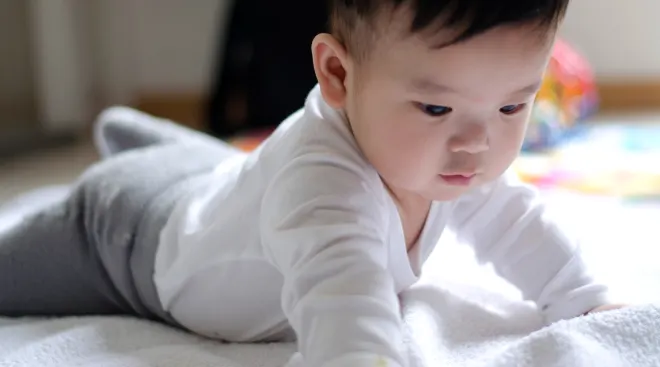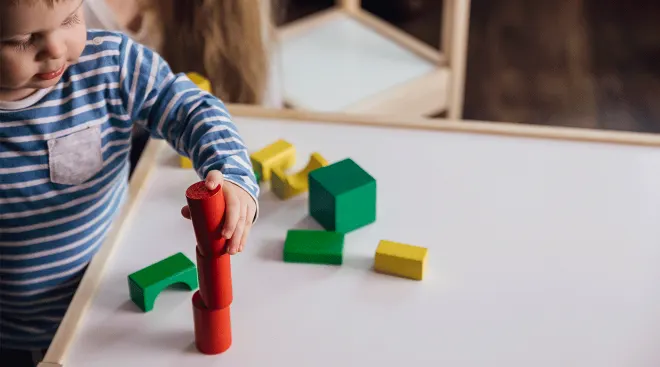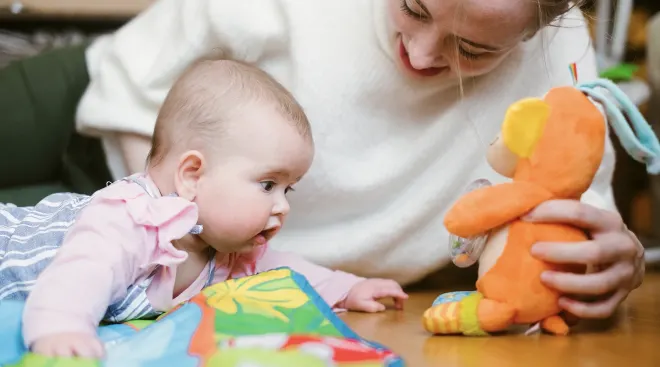Baby’s First Steps: When Do Babies Start Walking?
Ready to hear the pitter-patter of those little feet on the floor? It’s one of the most anticipated milestones, and you’re probably eagerly waiting and wondering: When do babies start walking? There’s reason to applaud when baby’s first steps do happen—it’s a major developmental milestone and quite the feat for baby. So when do babies walk? Read on to learn about the age it typically happens, signs to watch for and how to encourage baby to walk independently.
At what age do babies walk? Unfortunately, there isn’t a definitive answer here, as there’s quite a large range for when babies start walking. Baby’s first steps can come as early as 9 months or as late as 18 months, says Denise Scott, MD, an Oklahoma-based pediatrician and expert with JustAnswer—and both ends are considered to be within normal range. “Parents often expect their baby to be taking steps at a year, but that’s not always the case,” Scott says.
What’s more, baby won’t hit the walking milestone overnight. In order to develop the necessary skills to take their first steps, babies need to progress through a series of other milestones (more on this below). “I think we forget how complicated walking really is,” says Natasha Burgert, MD, a pediatrician at Pediatric Associates in South Overland Park, Kansas. “Not only do baby’s leg muscles need to gain strength to carry their body weight, but walking also requires strong ankles, hips and core, and an increasingly mature sense of balance. Some babies will gain that combination of skills more quickly than others, since so many parts are in play.” Personality and temperament play a role too—even if baby has developed the skills to walk, it might take longer for them to get up the courage to actually do it. If you have a bolder baby, they may start walking sooner than later.
So how and when do babies start walking? Rather than measuring by age, experts recommend looking for developmental signs baby will walk soon. The road to walking independently begins very early on as you let baby practice tummy time, which helps strengthen and develop good head and neck control. Tummy time sets baby up to learn how to roll over, sit up, crawl, pull up to stand and eventually cruise. Cruising typically happens once baby is between 8 to 12 months, Scott says, and involves babies taking small, tentative steps “while holding onto something, like a sofa, table or your hand.” (This is why it’s extra important to ensure furniture and other items within baby’s reach are securely child-proofed once baby’s on the move.)
“The acquisition of one skill builds to the next,” Burgert explains, so it’s normal for baby to spend a few weeks mastering each one before moving on. But remember that every child is different and may not follow this exact progression. “Some children crawl for a few days and then get up and cruise, some crawl for months before they stand up and some children never crawl,” adds Carrie M. Brown, MD, a pediatrician at Arkansas Children’s Hospital in Little Rock, Arkansas.
The good news is you don’t need any fancy equipment to help baby build the key skills needed to start walking—just engage in playtime to help baby practice their motor skills. Ultimately, neurotypical “babies will walk despite anything parents do, but there are a few things that can be helpful,” Scott says. Below, some tips on how to encourage baby to walk.
-
Let them explore: We know you love cuddling and carrying baby, but it’s important to also allow them the space to move around independently. When teaching baby to walk, give them plenty of time each day to explore and develop their skills on their own so they become more interested in hitting the walking milestone. But never leave baby unattended once they’re on the move: “There are too many dangers they’ll find,” Scott says.
-
Minimize the time baby spends in a playpen or activity center. “The disc-type activity centers that infants and toddlers sit and play with toys in are fine, but they’re not helping with movement skills,” Brown says. If baby is confined to a playpen or stuck in an activity center, there’s not enough opportunity or room for them to crawl, stretch out, roll over or stand up, which could lead to a delay in walking. According to Brown, when it comes to developing those critical skills, it’s best to have baby on a safe floor away from furniture, sharp corners and any clutter they could trip over.
-
Offer support when baby needs it: While you’ll want to let baby explore on their own (with supervision), it’s also important to offer support as they need it. For example, as baby starts to walk with those initial shaky steps, hold their hand or finger to give them support and stability, Scott advises. You can also try sitting on the floor a few inches from baby, and encouraging them to try walking independently toward you.
-
Let baby go barefoot: While you may want to outfit baby in adorable shoes the second they start cruising, most experts recommend letting baby go barefoot at first, as it helps them balance. “Barefoot is the most stable for early walkers,” Scott says. “It allows baby to feel the surface underneath their feet, while shoes are more to protect their feet outdoors or in public places.”
-
Introduce a push toy: “Once baby is upright and cruising along furniture, a push toy can help them learn to walk forward with support,” Brown says. “Some of these toys can even have the wheels adjusted so they’ll move more slowly while the child is first learning.” But you don’t have to spend money on a new toy when teaching baby to walk. Burgert and Scott recommend letting baby just push a diaper box or upturned empty laundry basket around the house—both serve as effective (and low-cost!) push toys.
-
Skip the seated baby walker: While they’re popular with parents, they actually slow down baby’s learning-to-walk process. “Walkers keep the child in a seated position with hips flexed using their lower legs to move the walker forward, which isn’t a natural walking position,” Brown says. Walkers can also be dangerous if they roll down stairs, get stuck in narrow spaces or allow baby to reach unsafe items like cups of hot coffee and pans on the stove. This is why the American Academy of Pediatrics (AAP) recommends avoiding baby walkers altogether.
So when do babies walk on their own? Once baby’s first steps happen, it’s usually a matter of weeks (or even months) before they start taking more confident, steady strides and walking independently. “Some don’t feel comfortable unless at least holding onto a finger. Some babies will take off within a week,” Scott says. Again, this will vary from baby to baby. But once baby’s walking independently, running is a few short months away: Most kids will start running anytime between 18 and 24 months, Scott says.
Wondering when babies will start walking up and down stairs? This is the next motor milestone after running, but it can be more difficult to tackle. Initially, baby may try the stairs on all fours, on their bottom or by climbing them one at a time. Once baby starts to walk more steadily, you can let them attempt to climb the stairs by holding onto the railing and your hand. “Stairs are trickier to master and can be dangerous, but usually by age 2, a toddler can walk up and down them while holding a railing—some earlier,” Scott says. “By age 3, stairs are [usually] no problem for [kids].”
Wondering when babies should start wearing shoes? While barefoot is best when baby’s learning to walk, once they’re walking independently you’ll definitely want to start shopping for baby shoes. According to Scott, “Babies should wear shoes for walking outdoors or when out in public. In the house, barefoot or non-slip socks are fine.” And don’t feel like you need to buy anything high-end: Scott suggests going with relatively inexpensive shoes since toddlers will grow out of them quickly! Choose options with light, rubber and flexible soles that are easy to put on and help the muscles and bones in baby’s feet to develop properly. Options to avoid include smooth, slick and leather soles, as they may be harder for baby to balance in.
Many parents start to worry if baby isn’t walking by their first birthday—and even more with each passing month. Rest easy knowing that some babies are just late walkers. There are several causes of delayed walking, many of which aren’t serious and may simply be related to baby’s temperament. “It’s important to remember that milestones are not absolute,” Burgert says. “I’m more concerned when parents notice a regression of skills, or that a child isn’t even attempting to move forward in their progress.” For example, it’s more concerning if a child isn’t attempting to crawl or pull up by 12 months than if they’re actively pulling up and cruising but not yet walking at 15 months. “Even though both of these children have a relative motor delay, the concern is the lack of forward progress in the 12-month-old,” Burgert explains. Additionally, if you notice baby doesn’t want to bear weight on their legs by at most 12 months, Scott advises reaching out to your pediatrician. If you notice this sooner, don’t hesitate to flag it to your pediatrician. The good news: Baby’s development is monitored at each well-visit, which helps providers catch any of these signs, delays or issues early on.
Of course, any and all concerns about delayed walking in babies should be flagged with your pediatrician so they can evaluate if further testing is needed. As long as baby is moving in a positive direction with their development, they’re likely just taking their time in hitting the walking milestone. Enjoy it now—once baby takes off, you’ll be wistful for the days when you could sit still.
About the experts:
Denise Scott, MD, is a pediatrician with JustAnswer and a pediatric endocrinologist based in Oklahoma with over 30 years of experience. Certified in culinary medicine, Scott also runs the blog Feed Future Health and is the author of Feed Your Child’s Future Health: Prevent Disease before it Starts. She received her medical degree from the University of Texas Medical Branch and completed her residency at the University of Oklahoma Health Sciences Center, with a fellowship at the National Institutes of Health.
Natasha Burgert, MD, FAAP, is a pediatrician at Pediatric Associates in South Overland Park, Kansas and the blogger behind KC Kids Doc. She earned her medical degree from University of Nebraska Medical Center in Omaha, Nebraska, and completed her residency at Cincinnati Children’s Hospital Medical Center.
Carrie M. Brown, MD, is a pediatrician at Arkansas Children’s Hospital in Little Rock, Arkansas with over 20 years of experience. She earned her medical degree from Ross University School of Medicine and completed her residency at Central Iowa Health Systems-Iowa Methodist Medical Center.
Please note: The Bump and the materials and information it contains are not intended to, and do not constitute, medical or other health advice or diagnosis and should not be used as such. You should always consult with a qualified physician or health professional about your specific circumstances.
Plus, more from The Bump:
Carrie M. Brown, MD, is a pediatrician at Arkansas Children’s Hospital in Little Rock, Arkansas with over 20 years of experience. She earned her medical degree from Ross University School of Medicine and completed her residency at Central Iowa Health Systems-Iowa Methodist Medical Center.
Natasha Burgert, MD, FAAP, is a pediatrician at Pediatric Associates in South Overland Park, Kansas and the blogger behind KC Kids Doc. She earned her medical degree from University of Nebraska Medical Center in Omaha, Nebraska, and completed her residency at Cincinnati Children’s Hospital Medical Center.
Denise Scott, MD, is a pediatrician with JustAnswer and a pediatric endocrinologist based in Oklahoma with over 30 years of experience. Certified in culinary medicine, Scott also runs the blog Feed Future Health and is the author of Feed Your Child's Future Health: Prevent Disease before it Starts. She received her medical degree from the University of Texas Medical Branch and completed her residency at the University of Oklahoma Health Sciences Center, with a fellowship at the National Institutes of Health.
American Academy of Pediatrics, Baby Walkers: A Dangerous Choice, August 2022
Learn how we ensure the accuracy of our content through our editorial and medical review process.
Navigate forward to interact with the calendar and select a date. Press the question mark key to get the keyboard shortcuts for changing dates.




















































